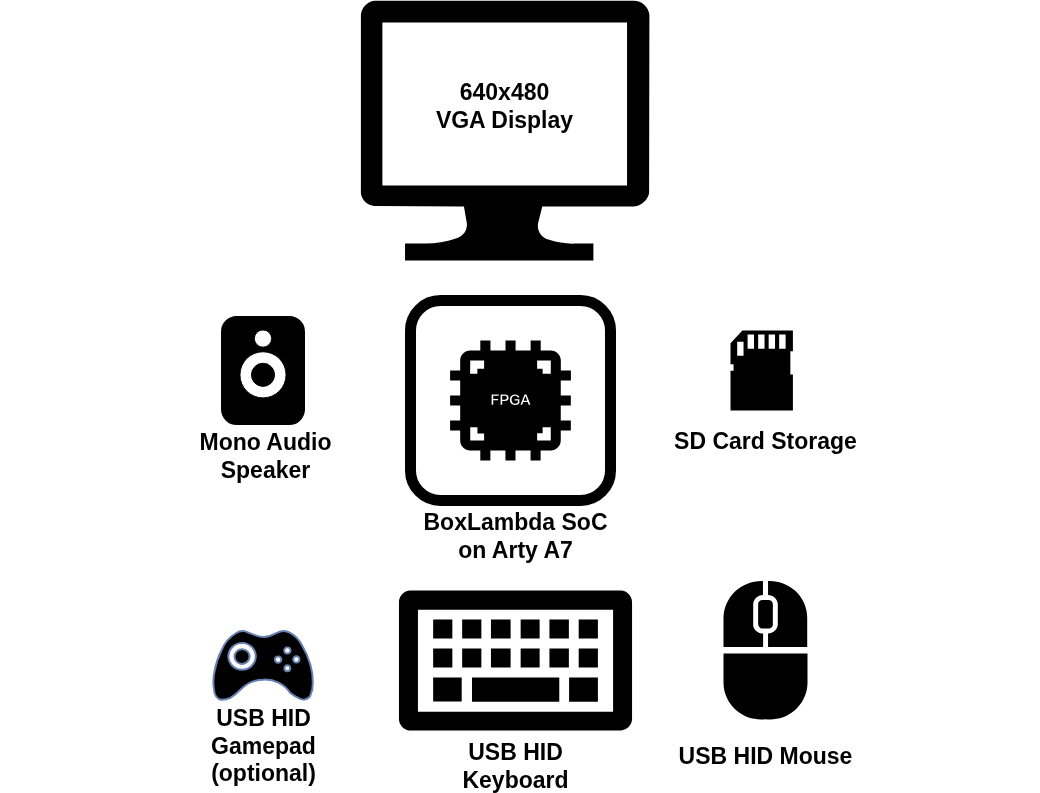About BoxLambda
BoxLambda is a hardware-software crossover project creating a homebrew, retro-style FPGA-based microcomputer. The goal is to create a sandbox environment for experimenting with software and FPGA gateware.
The Physical Setup
The physical setup.
Current Features
- Target FPGA: Arty-A7-100T.
- Ibex RISC-V core with machine timer and hardware interrupt support.
- Harvard architecture-based interconnect.
- Low-latency register and memory access across the SoC.
- Predictable instruction cycle counts.
- DFX Partial FPGA Reconfiguration support.
- DDR3 external memory access through the Litex memory controller.
- OpenOCD-based debug access on FPGA and Verilator.
- VERA-based VGA graphics: 2 layers, tile or bitmap mode, 2 banks of 64 sprites, 128KB Video RAM, 256 color palette.
- Dual YM2149 PSG Audio.
- SD Card Controller and FatFs File System.
- 24-pin GPIO, UART, SPI Flash Controller, I2C Controller.
- Real-time Clock and Calendar (RTCC) support.
- USB HID Keyboard and Mouse support.
- Picolibc-based standard C environment.
- Test application suite covering all SoC components, running on both FPGA and Verilator.
- Mecrisp Forth core + C FFI.
Gateware Block Diagram

Software Block Diagram
BoxLambda OS Architecture Block Diagram.
Key Goals
- Create a sandbox for experimenting with software and FPGA gateware:
- It should be easy to jump in and do something: create, hack, tinker.
- Simple Enough for One Person: A motivated individual can develop a solid understanding of the entire system, including software and hardware.
- Deterministic Behavior: The duration of operations such as internal memory or register access must be predictable by design.
- Self-Contained Run-Time Environment supporting high-level interactive and low-level systems programming.
- Create a Modular Architecture allowing for a mix-and-match of software and hardware components. Optionally, support Partial FPGA Reconfiguration.
- It should be easy to jump in and do something: create, hack, tinker.
-
Target Hardware: Digilent’s Arty-A7.
- The computer supports the following peripherals:
- USB HID Keyboard
- USB HID Mouse (optional)
- USB HID Joystick (optional)
- Real-Time Clock and Calendar (optional)
- Serial port
- SD card storage
- Flash Memory storage
- VGA Display
- Audio output
- Sound and graphics support retro-style 2D demos and gameplay.
Status (December 2025)
- Infrastructure (build system, etc.): Complete.
- Gateware: Complete and meeting requirements.
- Software: Early stage development. OS architecture defined. BoxLambda C Core partially completed. Mecrisp Forth Core partially completed. Mecrisp Forth Environment not started yet.
Links
- Source Code: https://github.com/epsilon537/boxlambda/
- Project Blog: https://epsilon537.github.io/boxlambda/
- Project Documentation: https://boxlambda.readthedocs.io/en/latest/

